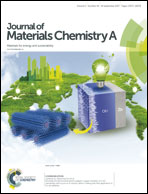Few-layer MoS2 anchored at nitrogen-doped carbon ribbons for sodium-ion battery anodes with high rate performance†
Abstract
Carbon-based anode materials are faced with challenges in rechargeable sodium-ion batteries (SIBs). In this paper, we describe a substrate, N-doped amorphous micron-sized carbon ribbons (AMCRs), derived from biomass from raupo, on which few-layer MoS2 nanosheets with enlarged interlayer spacings (≈0.75 nm) are anchored. The nitrogen-enriched AMCRs are economically prepared by a single pyrolysis step. The uniform distribution of nitrogen atoms enables ultra homogeneous growth of the MoS2 nanosheets on the AMCRs. The as-prepared AMCRs@MoS2 composite is fabricated as an anode material for SIBs, and carboxymethylcellulose (CMC) and polyvinylidene fluoride (PVDF) are chosen as binders to mix the anode materials to compare their battery performance. The anode composite with CMC as the binder demonstrates an improved initial coulombic efficiency of 75.6%, a higher specific capacity (366 mA h g−1 at a current density of 1 A g−1) and a better cycling stability (305 mA h g−1 after 300 cycles). The anode material composed of few-layer MoS2 anchored on low-cost nitrogen-doped AMCRs with CMC as the binder can be a competing candidate for large-scale SIB production.



 Please wait while we load your content...
Please wait while we load your content...